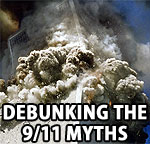No Stand-Down Order
Claim: No fighter jets were scrambled from any of the 28 Air Force bases within close range of the four hijacked flights. "On 11 September Andrews had two squadrons of fighter jets with the job of protecting the skies over Washington D.C.," says the Web site emperors-clothes.com. "They failed to do their job." "There is only one explanation for this," writes Mark R. Elsis of StandDown.net. "Our Air Force was ordered to Stand Down on 9/11."
FACT: On 9/11 there were only 14 fighter jets on alert in the contiguous 48 states. No computer network or alarm automatically alerted the North American Air Defense Command (NORAD) of missing planes. "They [civilian Air Traffic Control, or ATC] had to pick up the phone and literally dial us," says Maj. Douglas Martin, public affairs officer for NORAD. Boston Center, one of 22 Federal Aviation Administration (FAA) regional ATC facilities, called NORAD's Northeast Air Defense Sector (NEADS) three times: at 8:37 am EST to inform NEADS that Flight 11 was hijacked; at 9:21 am to inform the agency, mistakenly, that Flight 11 was headed for Washington (the plane had hit the North Tower 35 minutes earlier); and at 9:41 am to (erroneously) identify Delta Air Lines Flight 1989 from Boston as a possible hijacking. The New York ATC called NEADS at 9:03 am to report that United Flight 175 had been hijacked — the same time the plane slammed into the South Tower. Within minutes of that first call from Boston Center, NEADS scrambled two F-15s from Otis Air Force Base in Falmouth, Mass., and three F-16s from Langley Air National Guard Base in Hampton, Va. None of the fighters got anywhere near the pirated planes.
Why couldn't ATC find the hijacked flights? When the hijackers turned off the planes' transponders, which broadcast identifying signals, ATC had to search 4500 identical radar blips crisscrossing some of the country's busiest air corridors. And NORAD's sophisticated radar? It ringed the continent, looking outward for threats, not inward. "It was like a doughnut," Martin says. "There was no coverage in the middle." Pre-9/11, flights originating in the States were not seen as threats and NORAD wasn't prepared to track them.
Flight 175's Windows
Claim: On Sept. 11, FOX News broadcast a live phone interview with FOX employee Marc Birnbach. 911inplanesite.com states that "Bernback" saw the plane "crash into the South Tower." "It definitely did not look like a commercial plane," Birnbach said on air. "I didn't see any windows on the sides."
Coupled with photographs and videos of Flight 175 that lack the resolution to show windows, Birnbach's statement has fueled one of the most widely referenced 9/11 conspiracy theories — specifically, that the South Tower was struck by a military cargo plane or a fuel tanker.

Plain View: Passenger windows on a piece of Flight 175's fuselage. (Photograph by William F. Baker/FEMA)
FACT: Birnbach, who was a freelance videographer with FOX News at the time, tells PM that he was more than 2 miles southeast of the WTC, in Brooklyn, when he briefly saw a plane fly over. He says that, in fact, he did not see the plane strike the South Tower; he says he only heard the explosion.
While heading a Federal Emergency Management Agency (FEMA) probe into the collapse of the towers, W. Gene Corley studied the airplane wreckage. A licensed structural engineer with Construction Technology Laboratories, a consulting firm based in Skokie, Ill., Corley and his team photographed aircraft debris on the roof of WTC 5, including a chunk of fuselage that clearly had passenger windows. "It's ... from the United Airlines plane that hit Tower 2," Corley states flatly. In reviewing crash footage taken by an ABC news crew, Corley was able to track the trajectory of the fragments he studied — including a section of the landing gear and part of an engine — as they tore through the South Tower, exited from the building's north side and fell from the sky.
Intercepts Not Routine
Claim: "It has been standard operating procedures
for decades to immediately intercept off-course planes that do not respond to communications from air traffic controllers," says the Web site oilempire.us. "When the Air Force 'scrambles' a fighter plane to intercept, they usually reach the plane in question in minutes."
FACT: In the decade before 9/11, NORAD intercepted only one civilian plane over North America: golfer Payne Stewart's Learjet, in October 1999. With passengers and crew unconscious from cabin decompression, the plane lost radio contact but remained in transponder contact until it crashed. Even so, it took an F-16 1 hour and 22 minutes to reach the stricken jet. Rules in effect back then, and on 9/11, prohibited supersonic flight on intercepts. Prior to 9/11, all other NORAD interceptions were limited to offshore Air Defense Identification Zones (ADIZ). "Until 9/11 there was no domestic ADIZ," FAA spokesman Bill Schumann tells PM. After 9/11, NORAD and the FAA increased cooperation, setting up hotlines between ATCs and NORAD command centers, according to officials from both agencies. NORAD has also increased its fighter coverage and has installed radar to monitor airspace over the continent.

